
Big Barcode FAQ
Answers to your barcode questions.
For help using our software, visit the technical support page. Be sure to check out our barcode tips and tricks for even more barcode information!

Getting Started With a Barcode Project
First decide which barcode type you need: Are there barcode specs or guidelines you have to adhere to? They will specify which symbology to use. If you're working with a business/trade partner who requires a specific barcode, ask them to provide you with detailed information. They should have written or online specifications to share with you.
What will be the barcode be used for? If you need barcodes for retail products use a UPC, EAN, JAN or ISBN-13 barcode. For ZIP codes on U.S. mail use POSTNET. For labels or forms in shipping or inventory Code 128, Code 39, or Interleaved 2 of 5 (ITF) might be used.
Once you’ve determined the barcode type, outline your workflow. Things to think about:
The more you know, the better your results will be. Have a look around this site: check out our How-To's and the different barcode FAQs. Experiment with our free barcode font. If you still have questions, contact us - we’re here to help.
Can barcodes contain letters/numbers/punctuation?
Yes, no and maybe! Each symbology is constrained to a character set (the kind of data that can be encoded using that barcode type). Some - like UPC, ISBN, and EAN barcodes - are numbers-only. Code 39 and Code 128 barcodes can contain letters, numbers, and some punctuation marks. To avoid frustration, check the information about each symbology's character set before you get started.
Can I make up my barcode numbers?
For in-house tracking numbers, SKUs, part numbers, inventory IDs, etc, yes. Barcode types like Code 39, Interleaved 2 of 5, Code 128 and others are used to create this kind of barcode.
For barcodes like UPC, ISBN, ISSN, JAN, and EAN, no. These symbologies are closed systems, and a portion or all of the digits used in them should be obtained from a standards body. GS1 administers EAN, JAN and UPC numbers. ISSNs are administered by the ISSN International Centre. ISBNs are administered by Bowker.
How do I make a barcode?
How do I scan a barcode?
By using a barcode scanner (or 'reader') or an app on your smart phone. Some 2D barcode types require special 2D barcode scanners.
What are barcode specs and standards?
1. Written or online requirements from a trade partner describing which barcode type should be used, what data the barcode should contain, and generally the desired size, shape and location of the barcode on shipping documents, labels, products, pallets, etc. If you're working with a company that requires a barcode from you, be sure to review their barcode spec before purchasing barcode software, or investing time and energy in creating and printing barcodes. Never guess!
2. Standards regarding the specific size, shape, data structure, and set of characters that may be used in a barcode. These specs are universal: a Code 128 barcode of 'XYZ123' made in France is identical to a Code 128 barcode of 'XYZ123' created in Tibet, for example. Some data structures and barcode types are regulated by standards bodies like GS1 (UPC barcodes and others), or private companies like Bowker (ISBN barcodes).
What are barcodes used for?
Barcodes are symbol codes used to encode pieces of data like SKUs, part numbers, ID information, Universal Product Codes, or other information. Data in a barcode is often a lookup reference to more comprehensive information held in a database. When printed onto (or affixed to) an item, scanning barcodes allows for quick, error-reduced inventory/asset/item management.
What are the benefits of using barcodes?
Barcodes enable automated work processes without human intervention. Auto-ID technology like barcodes is sometimes called 'keyless data entry'. Barcodes are fast and accurate, never hungover or typo-prone. The use of barcodes eliminates many common workflow errors and can save significant time and money. Once an accurate barcoding system is in place there are consistent results, without error, at minimal cost.
What barcode types are there?
1D (one-dimensional) or 'linear' barcodes made up of upright lines and spaces of varying width (varying height for POSTNET barcodes) in a horizontal pattern, and 2D (two-dimensional) rectangular or square codes with a black crossword-like grid or 'honeycomb' pattern, are the most common barcode types. The glossary at the top of this page includes most 1D and many 2D barcodes. There also exist a handful of barcode types outside of 1- and 2D, though they are often proprietary codes created by private companies.
What is a 1D barcode?
One-dimensional, or 'linear' barcodes are read left-to-right or right-to-left, and can contain a limited number of characters. 1D barcodes are made up of upright lines and spaces of varying width (varying height for POSTNET barcodes) in a horizontal pattern. Most common barcode symbologies - UPC, Code 128, , Interleaved 2 of 5, EAN, ISBN - are 1D.
What is a 2D barcode?
2D, or two-dimensional, barcodes are more complex than standard 1D barcodes, and many can hold hundreds or thousands of characters of data. They're rectangular or square with a black crossword-like grid or 'honeycomb' pattern. 2D barcode symbologies include DataMatrix, QR code, PDF417, and a few others. A special 2D barcode scanner is often required to read 2D codes except QR barcodes which can be scanned with smartphones (and the right scanning app). Many standard barcode scanners are designed to only read 1D barcode symbologies like Code 128 and UPC.
What is a barcode?
A barcode is printed pattern code - parallel lines of varying widths, a grid, varying shapes or symbols - that can be read by a scanner (or 'reader'). This attribute is called 'machine-readable'. The printed code contains data - depending on symbology this can be letters, numbers, and some punctuation marks.
What’s a barcode scanner?
A barcode scanner (or barcode 'reader') is an electronic device that can decode and translate printed barcodes to a human-readable format on the scanner's screen or on a computer. Barcode scanners typically consist of a light source, a lens and a light sensor that decodes the printed symbol patterns by way of differentiating between dark ink and light background.
What’s in a barcode?
Barcodes can contain different kinds of information, depending on which barcode symbology is used. Many 1D barcodes like UPC or Code 128 are simple lookup numbers linked to a database that contains the 'real' data. For example the UPC barcode on a can of peas at a grocery store is linked to the store's database. That database contains comprehensive information like the product's brand name, price, size, the number of cans in stock, etc.
Other barcodes contain small chunks of text: letters, numbers, some punctuation. An example is an ID badges with your first initial, last name, plus your employee number. Many numeric barcodes include a check digit to insure data integrity.
More complex codes like QR and other 2D barcodes can contain entire paragraphs of information, including phone numbers, mailing addresses, latitude/longitude information, or web addresses.
Which barcode should I use?
Are there barcode specs or guidelines you have to adhere to? They will specify which symbology to use. If you're working with a business/trade partner who requires a specific barcode, ask them to provide you with detailed information. They should have written or online specifications to share with you.
If your numbers came from a standards body, read their standards and requirements for which barcode type you should use. If your barcodes will only be used in-house, you can choose the barcode type that's appropriate for your data (numbers, letters, punctuation marks, or all of the above) and your barcode scanners.
What will be the barcode be used for? If you need barcodes for retail products use a UPC, EAN, JAN or ISBN-13 barcode. For ZIP codes on US mail, use POSTNET. For labels or forms in shipping or inventory Code 128, Code 39, or Interleaved 2 of 5 (ITF) can be used.
2 of 5 (non-interleaved)

2 of 5, a numbers-only symbology, is among the oldest barcode types. While increasingly rare, they are still used in certain situations, such as printing onto rough materials, in baggage handling, airline ticketing and photo-finishing labs.
2D barcode
2D, or two-dimensional, barcodes are more complex than standard 1D barcodes. They contain larger chunks of information and are rectangular or square with a black crossword-like grid or 'honeycomb' pattern. 2D barcode symbologies include DataMatrix, QR code, PDF417, and a few others. A special 2D barcode scanner is often required to read 2D codes (though QR codes can be read by many smartphone apps). Many standard barcode scanners are designed to only read 1D barcode symbologies like Code 128 and UPC.
application identifier (AI)
Application identifiers (AI) are codes inserted into the beginning of barcodes to indicate a specific measurement, quantity, location, 'best by' date, and more. Companies up and down the trade chain make use of the same universal open-standard GS1 codes.
Barcode
A barcode is printed pattern code - parallel lines of varying widths, a grid, varying shapes or symbols - that can be read by a scanner (or 'reader'). This attribute is called 'machine-readable'. The printed code contains data - depending on symbology this can be letters, numbers, and some punctuation marks.
barcode font

A barcode font is a font designed to display and print a predetermined set of lines and spaces in varying widths. Those lines and spaces convey the original data - letters, numbers, some punctuation marks - that has been encoded. They are readable by barcode scanners but not (typically) to the human eye. With most barcode fonts you can't simply type your data in that font and create a scannable barcode; most barcodes must be created in a barcode wizard or encoder.
barcode specification
There are two common meanings:
1. Written or online requirements from a trade partner describing which barcode type should be used, what data the barcode should contain, and generally the desired size, shape and location of the barcode on shipping documents, labels, products, pallets, etc. If you're working with a company that requires a barcode from you, be sure to review their barcode spec before purchasing barcode software, or investing time and energy in creating and printing barcodes. Never guess!
2. Standards regarding the specific size, shape, data structure, and set of characters that may be used in a barcode. These specs are universal: a Code 128 barcode of XYZ123 made in France is identical to a Code 128 barcode of XYZ123 created in Tibet, for example. Some data structures and barcode types are regulated by standards bodies like GS1 (UPC barcodes and others), or private companies like Bowker (ISBN barcodes).
Bookland
Bookland is an older barcode format used on books. It has been replaced by ISBN-13 barcodes (International Standard Book Number). The two terms are sometimes used interchangeably but ISBN-13 is correct.
check digit/check sum

A check digit - or check sum - is a character appended to the data encoded in a barcode. Its purpose is to confirm the integrity of the scanned data. Check digits are based on algorithms and can be calculated in a number of different ways, depending on the type of barcode. They are mandatory in some symbologies like Code 128 and UPC, optional in some like Code 39, and superfluous in Interleaved 2 of 5. Specific implementations and requirements may dictate check digits separate and apart from the basic symbology.
Codabar

Codabar is a numbers-only barcode symbology used by FedEx, libraries, and blood banks.
Code 128
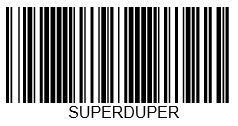
Code 128 is a very common barcode symbology used in a number of different situations including shipping label specifications, inventory and distribution. It’s dense and compact, squeezing more data into a space compared to Code 39. It’s variable-length, alphanumeric (letters and numbers), and supports the lower 128 ASCII characters (hence its name). Code 128 includes a mandatory mod 103 check digit.
Code 128 has three subsets:
Code 39 (3 of 9)

Code 39 (sometimes called '3 of 9') is an older and still popular symbology used for ID, inventory, and tracking purposes. It has a variable length, supports alphanumeric (numbers and letters) data, and can be printed at a variety of sizes and aspect ratios. Code 39 is the bar code used anywhere a fast, simple barcode is needed.
The standard character set is 43 characters: A-Z uppercase, 0-9, and punctuation marks -, ., $, /, +, %, and space. Each character is composed of nine elements: five bars and four spaces. Three of the nine elements in each character are wide (thus the name) and six elements are narrow. The full ASCII version supports the lower 128 ASCII characters but the symbols are twice as wide. A check digit is not required, though there exists a rarely-used optional check digit.
Code 93

Code 93 is a compact barcode symbology used on electronic components, and by Canada Post to encode supplementary delivery information. It is an alphanumeric (letters and numbers), variable length symbology that can include upper case letters, 0-9 and punctuation marks -, ., $, /, +, %, and space. Every symbol includes two check characters.
Due to the similarity of their names, Code 93 and Code 39 are easily mistaken for each other. Be sure to double check your spec before purchasing.
code set/subset
Codeset (or subset) in barcoding typically refers to the three types of Code 128 barcode: a, b and c.
Company prefix
A company prefix - sometimes called a manufacturer number - is assigned by by the barcode standards body GS1. A company prefix uniquely identifies each individual company when used as part of a barcode like a UPC or GS1-128, or a data structure like a GLN.
Data Matrix
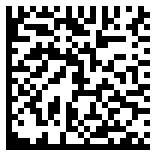
Data Matrix is a 2D (two-dimensional) symbology that can contain a large amount of data including all letters, numbers and punctuation marks. It’s the basis for the UID (Universal Identification) symbols mandated by the Department of Defense.
DPI
Dots per inch (dpi) is the density of dots in print or video, particularly the number of individual dots in a line within a one inch span. Typically the higher the dpi, the higher the image quality.
EAN
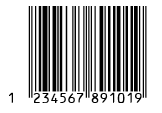
EAN stands for European Article Number. EAN are numbers-only barcodes used on retail items (outside of the US and Japan) and in a variety of other ways, including product identification in the global retail channel.
embedding (fonts)
Font embedding is an inclusion of font files in an electronic document; this means that the recipient of the document will be able to view and print all the fonts used in the original document, even if those fonts are not installed on their computer. Embedding fonts is especially important when sharing documents that contain barcodes created with barcode fonts.
Encoding
In barcoding, encoding is the process of converting data (letters, numbers, punctuation marks) into coded form. With Azalea software data is first passed through our encoder then rendered into a corresponding barcode font. This is why it's important to remember that you can't simply type your data into a barcode font; barcodes must be created in a barcode wizard, or using our code for Excel, Crystal Reports, etc.
FNC1 (Function Code 1)
FNC1 is a flagging code used in the creation of GS1 data structures, particularly GS1-128 codes. The FNC1 in a code marks the separation of Application Identifiers.
GDTI
Global Document Type Identifier
GIAI
Global Individual Asset Identifier
GINC
Global Identification Numbers for Consignment
GLN
Global Location Number
GRAI
Global Returnable Asset Identifiers
GS1
Global Standards - an international not-for-profit standards body that develops and maintains standards for supply and demand chains across multiple sectors. They administer company prefixes for use in UPC barcodes, GTINs, and many more.
GS1-128
GS1-128 barcodes are a specific type of Code 128 that encodes GS1 System element strings. They were previously called UCC/EAN-128 barcodes, and many written specifications still use the two terms interchangeably.
GS1-128 barcodes begin with a FNC1 (function one) character to designate them as GS1 System standard-compliant. They have a specific format and structure, and include GS1 System Application Identifiers. GS1-128 barcodes are used in warehousing, distribution and shipping, and are required in several industry standards and labeling guidelines.
GSIN
Global Shipment Identification Numbers
GSRN
Global Service Relation Numbers
GTIN
Global Trade Item Numbers. GTIN is one of the more common data structures used in retail shipping and trade. Often, a 14-digit GTIN will be required when moving your products from place to place; this allows products to be tracked at each step in the trade process. Those 14 digits may include your 11- or 12-digit UPC number plus two leading zeros.
human readable
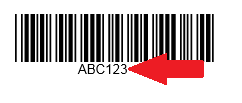
Human-readables are the numbers or characters above, below or beside a barcode, printed specifically to be read by people.
Intelligent Mail Barcode (USPS)
The Intelligent Mail barcode is a 65-bar barcode used for domestic mail in the United States. The US Postal Service offers a guide and downloadable resources here.
Interleaved 2 of 5 (ITF)

Interleaved 2 of 5 barcodes are a numbers-only symbology that is relatively compact because information is encoded in both the bars and the spaces. Because ITF encodes pairs of digits, the original data must be an even number of characters long. Two out of every five bars or spaces are in an ITF barcode are wide (hence the name). Interleaved 2 of 5 bar codes are used on corrugated boxes, in the shipping industry, on some commercial film, and in laboratories.
ISBN-13
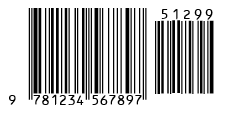
International Standard Book Numbers are the retail barcodes used on books and book-related products. They are EAN-13 barcodes with a 5-digit price supplemental. ISBNs are numbers-only, and should be obtained from the standards body Bowker.
ISSN
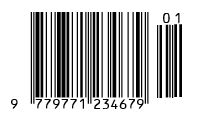
International Standard Serial Number. ISSNs are 8-digit, numbers-only barcodes used on print or electronic periodicals (newspapers and magazines). The ISSN International Centre administrates ISSN resources and information.
JAN
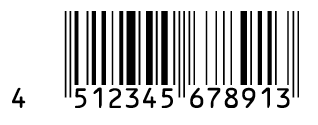
Japanese Article Number. A JAN is an EAN barcode that begins with '45' or '49', the country codes for Japan.
Maxicode
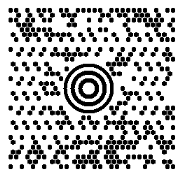
MaxiCodes - sometimes called UPS codes, or 'target' codes - are a public-domain 2D symbology created by United Parcel Service for fast package sortation.
MSI-Plessey

MSI-Plessey is a numbers-only symbology used in libraries and for inventory control and marking in warehouses.
OCR-A/OCR-B
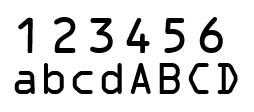
Optical Character Recognition codes are a human- and machine-readable font made up of letters and numbers. Their current usage is relatively limited, used primarily on bank checks and documents, though OCRs sometimes are used as a simple design font.
PDF417
A stacked, linear 2D barcode symbology. PDF stands for Portable Data File, and 417 indicates that each pattern in the code is made up of 4 bars and spaces, and each pattern is 17 units long. PDF417 is found on driver's licenses and ID cards, boarding passes, and some printable postage in the US. They can contain up to about 1100 bytes of information, and must be scanned using a 2D barcode reader.
POSTNET

POSTNET are numbers-only barcodes used to encode ZIP codes on US mail. Unlike other barcodes, POSTNET symbols consist of bars that vary in height, not width. A check digit is appended to the bar code, which can be used for 5-digit ZIP codes, 9-digit ZIP+4 codes or 11-digit Delivery Point Barcodes.
QR Code

Quick Response barcodes are 2D (two-dimensional) barcodes originally created for the Japanese automotive industry. They can contain large amounts of data, including web addresses, making them popular for consumer advertising like fliers, posters, postcards and links. QR barcodes can be scanned with a smartphone's scanning app.
RFID
Radio Frequency Identification - a technology that uses electromagnetic or electrostatic coupling in the radio frequency to uniquely identify an object. This technology can be placed into 'chips' that when affixed to items make inventory, shipping and tracking of items more efficient.
SSCC
Serial Shipping Container Code
Supplemental
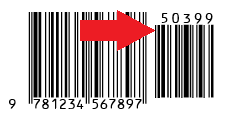
Supplemental barcodes are the numbers-only barcode to the right of a UPC, EAN or ISBN-13 barcode. Supplementals are either two or five digits, and typically contain the issue number or price of the item. If a supplemental is required for your barcode it will be a part of your barcode spec.
Symbology
Symbology is another name for barcode type.
UCC
Uniform Code Council is the original name of the barcode standards body now called GS1. Some older barcode specs and resources still refer to UCC-128 barcodes, UCC/EAN code, etc.
UPC (UPC-A, UPC-E)

Universal Product Codes. UPC-A barcodes are a direct encoding of 12-digit UPC numbers which include a company prefix, product number, and check digit. They're used in the Australia, Canada, New Zealand, the UK, the US, and other countries on retail items scanned at the point of sale. If a retailer has asked you to put a UPC barcode on your products, they very likely mean a UPC-A.
UPC-E barcodes are 'zero-suppressed'. They're created in a compressed format that drops one or more of the zeros in the combined company prefix and item number. They have only one notch, unlike UPC version A symbols. Not all company prefixes can make UPC-E symbols. Some company prefixes allow more version E barcodes to be made because they end with two or more zeros. The last digit in the lower right corner is the mandatory UPC check digit. Always confirm UPC barcode specifications directly with your trade partners.
UPC numbers are part of a closed system and cannot be made up. They must be obtained from the barcode standards body GS1, or from a company that is authorized to allocate existing UPC numbers - like us.
Variable Length
Variable length means a barcode is not constrained to a specific number of characters: its length can vary.
ZIP Code barcode

ZIP code (POSTNET) barcodes are used to encode ZIP codes on US mail. Unlike other bar codes, POSTNET symbols consist of bars that vary in height, not width. A check digit is appended to the bar code, which can be used for 5-digit ZIP codes, 9-digit ZIP+4 codes or 11-digit Delivery Point Barcodes.
